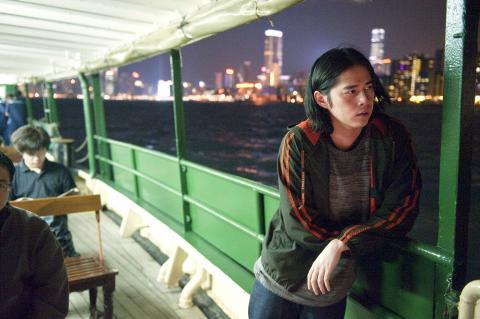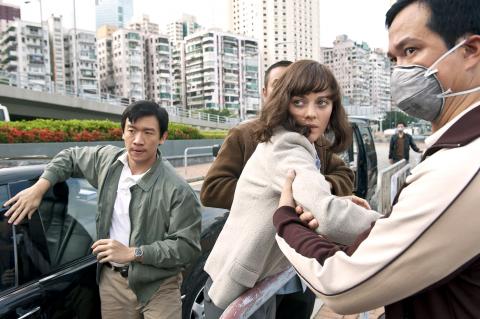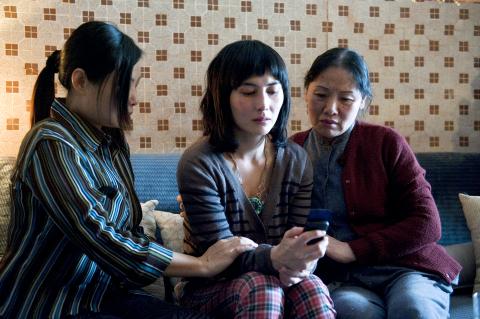Contagion, Steven Soderbergh’s smart, spooky thriller about a thicket of contemporary plagues — a killer virus, rampaging fear, an unscrupulous blogger — is as ruthlessly effective as the malady at its cool, cool center. Set in the world-is-flat now, the movie tracks a mystery pathogen after it catches a ride on a flight from Hong Kong to Chicago, an early hop for a globe-sprinting pandemic that cuts across borders and through bodies as effortlessly as Soderbergh moves among genres, styles and eras, this time by updating 1970s paranoia freakouts like All the President’s Men for the anti-government, Tea Party age.
Among the first casualties is an executive, Beth Emhoff (Gwyneth Paltrow), who, shortly after returning home from Hong Kong, is twitching on her Minneapolis kitchen floor, mouth foaming and eyes glassing over. Was it the moo goo gai pan? Not exactly, her husband, Mitch (Matt Damon in a small, crucial, sympathetic performance), soon learns. And that’s something you learn quickly in turn: Nothing moves slowly here, especially the disease, which, within days, cuts down seemingly everyone who’s been within touching, kissing, handshaking, dice-blowing distance of a carrier. Like the ladies in the old shampoo ads (“I told two friends about it and they told two friends and so on”) Beth just keeps on giving.
Working with regular collaborators like the writer Scott Z. Burns, the composer Cliff Martinez and the editor Stephen Mirrione, Soderbergh invests the story with visceral urgency, opening it with a screen steeped in black — an intimation perhaps of the looming abyss — and the sounds of a few hard, rasping coughs. This almost deviously funny overture is followed by a close-up of Beth wearing a sheen of sweat and no visible makeup, the image stamped “Day 2.” Listing forward, as if she was about to throw up on the camera tilted up at her, she looks about as bad as Paltrow probably can, given the ugly situation and the queasy-beautiful yellowish light that Soderbergh expressionistically employs throughout.

Photo courtesy of Warner Bros
She doesn’t vomit, but your own gorge may rise when the camera shifts from Beth — who takes a flirty call from her unseen lover, her wedding ring gleaming in the shot — to linger briefly on a jar of shelled peanuts set on the airport bar in front of her. Beth may be (relatively) bad, but those peanuts are murder, as is the credit card she hands to the waitress. The story subsequently hopscotches to several other people — a young man stumbling through a Hong Kong market, a Japanese salaryman grimacing on a plane and a model staggering in London — who flash in and out of the movie. Like Beth, whose young son, Clark (Griffin Kane), welcomes her home with open, vulnerable arms, each proves to be part of the lethal puzzle.
Those scrambling to put the pieces together include Ellis Cheever (Laurence Fishburne), a deputy director at the Centers for Disease Control and Prevention, and another doctor, Erin Mears (Kate Winslet), whom he sends into a chaotic field that, before long, is littered with the dead and populated by a mounting military presence. Rounding out a medical SWAT team, which is almost as self-consciously sexy and quirky as the thieves in Soderbergh’s Ocean’s movies, are a pair of Centers for Disease Control and Prevention doctors, Ally Hextall (a wonderful Jennifer Ehle) and David Eisenberg (Demetri Martin), who hoist test tubes and send rhesus monkeys to their deaths, as well as a sleuthing doctor for the WHO, Leonora Orantes (Marion Cotillard). Elliott Gould, one of Soderbergh’s favorites and a keystone Ocean’s player, adds to the casting pleasures.
There are a few obvious villains, notably a San Francisco blogger (Jude Law, snaggletoothed and embracing the designated creep role) with the unfortunate name of Alan Krumwiede, as in crumb-weedy. (Soderbergh also took aim at bloggers in The Girlfriend Experience.) A self-proclaimed outsider — “print media is dying,” he yells at a skeptical (and pregnant) newspaper editor — Krumwiede latches onto the pandemic early and before long is profiting from it on his blog (Truth Serum Now), where he pushes a holistic cure, forsythia, a yellow flowering plant used in traditional Chinese medicine. Soderbergh may like to play outside the cinematic mainstream now and then (as in Bubble), but there’s no place for alternatives like blogging and complementary medicine in Contagion, where the stakes are too catastrophically high.

Photo courtesy of Warner Bros
There’s another villain lurking (or rather bulldozing) in the shadows, but the most obvious peril is the virus, in and out of the laboratory. To that race-against-time end there are weirdly beautiful, near-surreal images of Ally and David wafting about in their violently red protective suits like space travelers heading off to science-fiction battle. Except that they — like the other good doctors, including Erin, seen wrangling one regional official who testily asks who’s paying for the triage services provided by the Federal Emergency Management Agency and other big-government groups — are terra-firma rationalists. They’re fighting a disease along with natural fear and unnatural fear mongers like Krumwiede, who, from his bloggy pulpit, dismisses science in the name of independence even as he sells out his readers.
In its dystopian vision of a present calamitously infected by fear, paranoia, self-interest and the denial of science, this movie is certainly of the moment even if it also evokes the past. At several points Krumwiede meets up with a speculator who’s looking to turn a profit on the crisis, in scenes that suggest Robert Redford, as Bob Woodward, hovering in the dark with Deep Throat in All the President’s Men. The meetings in the two movies are conspicuously different in look and intent, yet the characters seem to be gasping the same unclean air as they shed light on a shadow world of power, greed and dirty tricks. One crucial difference being that in the 1970s it was the government that played the villain while this time it’s on the side of right.
Once it may have been hard to buy the swift collapse of order that is made palpably real in Contagion, if Hurricane Katrina and its aftermath had not already set the stage. Soderbergh doesn’t milk your tears as things fall apart, but a passion that can feel like cold rage is inscribed in his images of men and women isolated in the frame, in the blurred point of view of the dying and in the insistent stillness of a visual style that seems like an exhortation to look. The virus seriously rattles your nerves, and you may want to start stockpiling antibacterial soap now. Yet what’s really scary in Contagion is how fast once-humming airports and offices, homes and cities empty out when push comes to shove comes to panic in the streets.

Photo courtesy of Warner Bros

One of the most important gripes that Taiwanese have about the Democratic Progressive Party (DPP) is that it has failed to deliver concretely on higher wages, housing prices and other bread-and-butter issues. The parallel complaint is that the DPP cares only about glamor issues, such as removing markers of Chinese Nationalist Party (KMT) colonialism by renaming them, or what the KMT codes as “de-Sinification.” Once again, as a critical election looms, the DPP is presenting evidence for that charge. The KMT was quick to jump on the recent proposal of the Ministry of the Interior (MOI) to rename roads that symbolize

On the evening of June 1, Control Yuan Secretary-General Lee Chun-yi (李俊俋) apologized and resigned in disgrace. His crime was instructing his driver to use a Control Yuan vehicle to transport his dog to a pet grooming salon. The Control Yuan is the government branch that investigates, audits and impeaches government officials for, among other things, misuse of government funds, so his misuse of a government vehicle was highly inappropriate. If this story were told to anyone living in the golden era of swaggering gangsters, flashy nouveau riche businessmen, and corrupt “black gold” politics of the 1980s and 1990s, they would have laughed.

It was just before 6am on a sunny November morning and I could hardly contain my excitement as I arrived at the wharf where I would catch the boat to one of Penghu’s most difficult-to-access islands, a trip that had been on my list for nearly a decade. Little did I know, my dream would soon be crushed. Unsure about which boat was heading to Huayu (花嶼), I found someone who appeared to be a local and asked if this was the right place to wait. “Oh, the boat to Huayu’s been canceled today,” she told me. I couldn’t believe my ears. Surely,

When Lisa, 20, laces into her ultra-high heels for her shift at a strip club in Ukraine’s Kharkiv, she knows that aside from dancing, she will have to comfort traumatized soldiers. Since Russia’s 2022 invasion, exhausted troops are the main clientele of the Flash Dancers club in the center of the northeastern city, just 20 kilometers from Russian forces. For some customers, it provides an “escape” from the war, said Valerya Zavatska — a 25-year-old law graduate who runs the club with her mother, an ex-dancer. But many are not there just for the show. They “want to talk about what hurts,” she